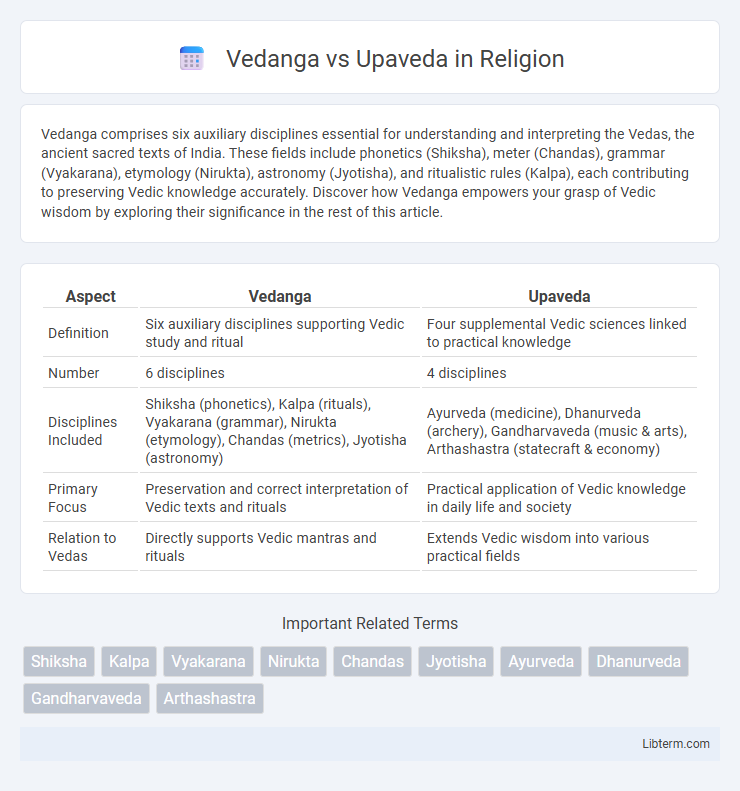Vedanga comprises six auxiliary disciplines essential for understanding and interpreting the Vedas, the ancient sacred texts of India. These fields include phonetics (Shiksha), meter (Chandas), grammar (Vyakarana), etymology (Nirukta), astronomy (Jyotisha), and ritualistic rules (Kalpa), each contributing to preserving Vedic knowledge accurately. Discover how Vedanga empowers your grasp of Vedic wisdom by exploring their significance in the rest of this article.
Table of Comparison
| Aspect | Vedanga | Upaveda |
|---|---|---|
| Definition | Six auxiliary disciplines supporting Vedic study and ritual | Four supplemental Vedic sciences linked to practical knowledge |
| Number | 6 disciplines | 4 disciplines |
| Disciplines Included | Shiksha (phonetics), Kalpa (rituals), Vyakarana (grammar), Nirukta (etymology), Chandas (metrics), Jyotisha (astronomy) | Ayurveda (medicine), Dhanurveda (archery), Gandharvaveda (music & arts), Arthashastra (statecraft & economy) |
| Primary Focus | Preservation and correct interpretation of Vedic texts and rituals | Practical application of Vedic knowledge in daily life and society |
| Relation to Vedas | Directly supports Vedic mantras and rituals | Extends Vedic wisdom into various practical fields |
Introduction to Vedanga and Upaveda
Vedanga refers to the six auxiliary disciplines in Vedic tradition, including phonetics, grammar, and astronomy, essential for understanding and interpreting the Vedas. Upaveda represents the supplementary knowledge systems like Ayurveda, Dhanurveda, and Gandharvaveda, which expand on practical applications in health, warfare, and arts. While Vedanga forms the foundational framework for Vedic studies, Upaveda extends Vedic wisdom into specialized fields of life and culture.
Definition and Meaning of Vedanga
Vedanga refers to the six auxiliary disciplines fundamental to understanding and interpreting the Vedas, including phonetics, grammar, meter, astrology, rituals, and etymology. These disciplines serve as essential tools to ensure the accurate transmission and application of Vedic knowledge. Upaveda, in contrast, consists of supplementary texts related to practical sciences like Ayurveda, Dhanurveda, and Gandharvaveda, which extend Vedic wisdom into specialized fields beyond ritualistic study.
Definition and Meaning of Upaveda
Upaveda refers to the auxiliary disciplines in ancient Indian tradition that support the understanding and application of Vedic knowledge, often categorized into Ayurveda, Dhanurveda, Gandharvaveda, and Shilpaveda. Unlike Vedanga, which comprises six limbs focusing on the phonetics, grammar, and rituals essential to interpreting the Vedas, Upaveda extends practical knowledge related to health, warfare, music, and crafts. The Upaveda serves as a complementary body of knowledge enriching the spiritual and cultural dimensions of Vedic studies.
Historical Origins of Vedanga
Vedanga, emerging around 1000 BCE, refers to six auxiliary disciplines designed to support the understanding and preservation of the Vedas, including phonetics, grammar, and ritual instruction. Upaveda, considered later developments, are subsidiary texts branching from the core Vedic corpus, encompassing specialized fields like Ayurveda (medicine), Dhanurveda (archery), and Gandharvaveda (music). The historical origins of Vedanga are deeply intertwined with early Vedic scholarship aimed at maintaining the oral tradition and correct ritual practice, predating the more systematized and applied knowledge found in the Upavedas.
Historical Origins of Upaveda
Upaveda, rooted in ancient Indian tradition, evolved as specialized knowledge branches complementing the Vedas, with its historical origins tracing back to the early Vedic period around 1500 BCE. Unlike the Vedangas, which are six auxiliary disciplines focused on linguistic and ritual accuracy, the Upavedas encompass practical sciences such as Ayurveda (medicine), Dhanurveda (archery), Gandharvaveda (music), and Sthapatyaveda (architecture). These disciplines developed to apply Vedic principles to everyday life, emphasizing holistic well-being, art, and societal structure in Vedic culture.
Components of Vedanga
Vedanga consists of six essential disciplines--Shiksha (phonetics), Chandas (metrics), Vyakarana (grammar), Nirukta (etymology), Kalpa (ritual instructions), and Jyotisha (astronomy)--which support the proper understanding and practice of the Vedas. These components ensure accurate pronunciation, meter, linguistic analysis, ritual procedures, and cosmic timings integral to Vedic tradition. Upaveda, in contrast, refers to auxiliary texts like Ayurveda, Dhanurveda, Gandharvaveda, and Arthaveda that extend Vedic knowledge to practical arts and sciences.
Branches of Upaveda
Upaveda consists of four traditional branches: Ayurveda (medicine and health science), Dhanurveda (military science and archery), Gandharvaveda (music and performing arts), and Arthashastra (statecraft and economics). Each Upaveda complements the Vedic knowledge by applying spiritual principles to practical disciplines. Vedanga, on the other hand, focuses on six auxiliary sciences--Shiksha (phonetics), Vyakarana (grammar), Nirukta (etymology), Chandas (meter), Jyotisha (astronomy), and Kalpa (rituals)--supporting accurate interpretation of the Vedas.
Comparative Analysis: Vedanga vs Upaveda
Vedanga and Upaveda are distinct branches of ancient Indian knowledge; Vedanga focuses on six auxiliary disciplines essential for understanding and interpreting the Vedas, including phonetics, grammar, and ritual practices. In contrast, Upaveda represents specialized branches of knowledge related to the Vedas, such as Ayurveda for medicine, Dhanurveda for martial arts, and Gandharvaveda for music and arts. While Vedangas provide foundational linguistic and ritual support, Upavedas extend Vedic application into practical, everyday sciences and arts, highlighting their complementary yet divergent roles in Vedic scholarship.
Significance and Role in Vedic Literature
Vedangas are six auxiliary disciplines--phonetics, grammar, etymology, meter, astronomy, and rituals--that support the understanding and preservation of Vedic texts, ensuring accurate recitation and interpretation. Upavedas, considered supplementary Vedic sciences like Ayurveda (medicine), Dhanurveda (martial arts), Gandharvaveda (music), and Arthashastra (economics), expand the practical applications of Vedic knowledge beyond spiritual rituals. Both Vedangas and Upavedas hold significant roles in Vedic literature, with Vedangas maintaining textual integrity and Upavedas translating Vedic principles into diverse fields of life and society.
Influence on Later Indian Knowledge Systems
Vedanga, comprising six auxiliary disciplines like phonetics, grammar, and astronomy, laid the foundational framework for interpreting Vedic texts and influenced linguistic, ritualistic, and philosophical studies in later Indian knowledge traditions. Upaveda, including Ayurveda (medicine), Dhanurveda (military science), Gandharvaveda (music and arts), and Arthaveda (economics and polity), expanded practical applications beyond religious rites, shaping classical Indian medicine, martial arts, arts, and governance systems. The integration of Vedanga's linguistic precision and Upaveda's specialized expertise contributed significantly to the development of classical Indian sciences, arts, and statecraft.
Vedanga Infographic

 libterm.com
libterm.com